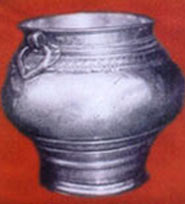Customary Reverence
Sixty-four Upacharas are
listed in sacred texts but in practice only 16 are offered--Shodasopachara,
fashioned after the customary reverence shown to an honoured
guest. They are:
1.Seating (Asana),
2.Welcome (Svagata),
3.0ffering water to wash the hands (Argya),
4.0fferingwater to the deity (Padya),
5.0fferingwater to sip and rinse the mouth (Achamana),
6.Providinga bath (Snana),
7.0ffering fresh clothes and decorations (Vasana-bhushana),
8.0ffering a fresh sacred thread (Yajnopavita),
9. Offering aromatic substances, such as sandal paste
(Gandha),
10. Offering flowers (Pushpa ),
11. Burnl11glOcense (Dhupa),
12. Waving lights (Deepa),
13. Offering four kinds of food (Naivedya),
14. Offering Tambu/a (betel leaves, arecanut, camphor
and spices),
15. Prostrations (Namaskara) along with circumambulations
(Pmdakshina), and
16. Send-off (Visarjana)"
If a worship has
to be brief, only five upacharas are gone through
and are called Panchopachara. Though called 'five'
services, Panchopachara are really six, including
naivedya--padya, gandha, pushpa, dhupa, deepa
and naivedya are these services.
These are common
to Vaikhanasa, Pancharatra, Saktya and Saiva
traditions and, thus, in spite of the different agamas
the worship is largely uniform.
The panchopachara
can also be elaborated Into ten (dasopachara)
customary services.
In affluent temples
,more details are added, such as offering of ornaments
(Abharana), decorations (Alankara),
holding a mirror (Darpana), applying unguents
(Anulepana), fanning with a fly-whisk (Chamara-vyajana),
presenting dance and music (Nartana, Gita-vadya),
reciting laudatory verses (Stuti) or Stotra),
presenting fire oblations (Homa) and providing
bed (Sayana).
Tri-kala
Puja is conducted with the first two sessions
merging into one. The morning session is the most elaborate,
when the deity is given a ceremonial bath (Abhiseka)
and customary decorations (Alankara).
 |
|
A
silver vessel with ears as handles |
|
water
is the most important offering in all the agamaic
rituals, and hence detailed norms are specified
for its collection, storage and usage inside the
sanctum for worship.
Water for
ritual use has to be freshly collected early in
the morning and for this purpose, fairly large pots
are used, Such pots and other vessels used for the
puja are artistically made, reflecting
the skill of the artisan.
The water
(now called Agrodaka) is poured into a
large vessel called drona, normally a stone
turf or a large silver or copper vessel with ears
as handles.
|
